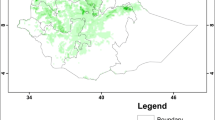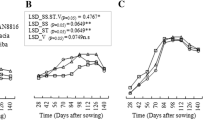Abstract
In the African subtropical zones, the choice of tillage practice is critical to sustainable rainfed crop production. Two season (2015 and 2016) field trials were conducted at Matopos Research Institute (20°24′S; 28°29′E, 1340 m above sea level) in southern Zimbabwe in order to determine dryland grain sorghum yield and 1000 kernel weight responses to tillage and mulch practices under African subtropical conditions. Sorghum grain yield was highest in planting basin tillage plots under 4 T ha−1 sorghum stover mulch application (3140.9 kg ha−1 for year 2015 and 3415.7 kg ha−1 for year 2016). The 1000 kernel weights in both years were least in ripper tillage and greatest in planting basin tillage field trial plots. The mass of 1000 sorghum kernels on planting basin tillage subplots under 2 T ha−1 sorghum stover mulching was 8.6 g (25.1%) and 8.4 g (24.2%) in excess of that recorded on mulched ripper subplots for 2015 season. For the season 2016, mass of 1000 sorghum kernels on planting basin tillage subplots under 4 T ha−1 sorghum stover mulching was 9.1 g (22.9%) and 8.4 g (21.1%) in excess of that recorded on mulched ripper subplots. The adoption of the planting basin tillage under sorghum stover mulching, a technology designed for smallholder farmers with limited access to animal draft power, can improve considerably the dryland sorghum grain yield and weight of 1000 kernels.






Similar content being viewed by others
References
Asadi ME (2017) Conservation agriculture practices in Golestan province, Iran: turning research into impact. Agric Mech 3:28–32
Astatke A, Jabbar M, Tanner D (2003) Participatory conservation tillage research: an experience with minimum tillage on an Ethiopian highland Vertisol. Agric Ecosys Environ 95:401–415
Aune JB, Bussa MT, Asfaw FG, Ayele AA (2001) The ox ploughing system in Ethiopia—can it be sustained. Outlook Agr 30:275–280
Baudron F, Tittonell P, Corbeels M, Letourmy P, Giller KE (2011) Comparative performance of conservation agriculture and current smallholder farming practices in semi-arid Zambia. Field Crops Res. https://doi.org/10.1016/j.fcr.2011.09.008
Beatley T, Brower DJ, Schwab AK (2002) An introduction to coastal zone management, 2nd edn. Island Press, Washington, DC, p 329
Bescansa P, Imaz MJ, Virto J, Hoogmoed WB (2006) Soil water retention as affected by tillage and residue management in semiarid Spain. Soil Tillage Res 87(1):19–27. https://doi.org/10.1016/j.still.2005.02.028
Bhadha JH, Alvarez O, Lang TA, Giurcanu MC, Daroub SH (2016) Growth efficacy of sorghum and rice amended with dried versus composted aquatic vegetation. Sustain Agric Res 5:92–102
Black GG, Hartge KH (1986) Bulk density. Methods of soil analysis. Part 3 ASA Madison, WI
Bouyoucos GJ (1965) Hydrometer method improved for making particle size analysis of soils. Agron J 27:738–741
Bremner JM (1996) N total. In: Sparks DL et al (eds) Methods of soil analysis: Part 3. Chemical methods, (Number 5) in the Soil Science Society of America. Book series Soil Science Society of America, Inc., American Society of Agronomy, Inc., Madison, Wisconsin, USA, pp 1085–1121
Fernandez CJ, Fromme DD, Grichar JW (2012) Grain Sorghum response to row spacing and plant populations in the Texas coastal bend region. Int J Agron. https://doi.org/10.1155/2012/238634
Chepngetich E, Bett EK, Nyamwaro SO, Kizito K (2014) Analysis of technical efficiency of Sorghum production in lower Eastern Kenya: a data envelopment analysis (DEA) approach. J Econ Sustain Dev 5(4):324–339
Daniel JB, Abaye AO, Alley MM, Adcoc CW, Maitland JC (1999) Winter annual cover crops in a Virginia. No-till cotton production system: II. Cover and tillage effects on oil moisture, cotton yield, and cotton quality. J Cotton Sci 3:84–91
Dicko MH, Gruppen H, Traore AS, Voragen AGJ, Berkel WJH (2006) Sorghum grain as human food in Africa: relevance of content of starch and amylase activities. Afr J Biotechnol 5(5):384–395
FAO/IIASA/ISRIC/ISS-CAS/JRC (2012) Harmonized world soil database (version 1.2). FAO, Rome
FAOSTAT (2013) Food and agricultural commodities production. Italy, Rome
Fernandez CJ, Fromme DD, Grichar WJ (2012) Grain sorghum response to row spacing and plant populations in the Texas Coastal Bend region. Int J Agron 4:1–6. https://doi.org/10.1155/2012/238634
Gebrekidan H (2003) Grain yield response of sorghum (Sorghum bicolor) to tied ridges and planting methods on entisols and vertisols of Alemaya, Eastern Ethiopia Highlands. J Agric Rural Dev Trop Sub Trop 104:113–128
Gebreyesus B, Wortmann CS, Mamo M, Gebrekidan H, Belay A (2006) Micro-basin tillage for grain sorghum production in semiarid areas of northern Ethiopia. Agron J 98:124–128
Gebreyesus BT, Wortmann CS (2008) Tie-ridge tillage for high altitude pulse production in northern Ethiopia. Agron J 100:447–453
Gulshan M, Rakesh S, Kumar A, Singh KG (2007) Effect of plastic mulch on economizing irrigation water and weed control in baby corn sown by different methods. Afr J Agric Res 2(1):19–26
Guzha AC (2004) Effect of tillage on soil micro-relief, surface depression storage and soil water storage. Soil Tillage Res 76:105–114
Hiremath SM, Hebbi BS, Halikatti SI (2003) Performance of rabi sorghum as influenced by nitrogen and in situ soil moisture conservation practices in kharif sunnhemp for green manuring. Karnataka J Agric Sci 16:216–219
Howell TA, Schneider AD, Dusek DA (2002) Effects of furrow diking on corn response to limited and full sprinkler irrigation. Soil Sci Soc Am J 66:222–227
Kassam A, Friedrich T, Derpsch R (2009) Global spread of conservation agriculture. Int J Environ Stud 7(4):292–320. https://doi.org/10.3763/ijas.2009.0477
Mupangwa W, Twomlow S, Walker S (2012) Reduced tillage, mulching and rotational effects on maize (Zea mays L.), cowpea (Vigna unguiculata (Walp) L.) and sorghum (Sorghum bicolor L. (Moench)) yields under semi-arid conditions. Field Crops Res 132:139–148
Nelson DW, Sommers LE (1996) Methods of determination of total organic carbon (TOC) in soils and sediments. In: Page 688 AL (ed) Total C, organic C and organic matter. Ecological Risk Assessment Center, Office of Research and Development, US. Environmental Protection Agency, Las Vegas, pp 456–691
Oldrieve B (1993) Conservation farming for small-scale resettlement and co-operative farmers of Zimbabwe. Mazonogororo paper converters, Pvt. Ltd, A Farm management handbook
Ozpinar S, Cay A (2005) Effects of minimum and conventional tillage systems on soil properties and yield of winter wheat (Triticum aestivum L.) in clay-loam in the Canakkale region. Turkish J Agric Forest 9:9–18
Pendke MS, Lomte MH, Gitte AU (2004) Effect of soil and water conservation practices on runoff, soil loss and yield of pigeon pea. J Maharashtra Agric Univ 29:319–321
Rockstrom J (2003) Water for food and nature in drought-prone tropics: vapor shift in rain-fed agriculture. Phil Trans R Soc Land 358:1997–2009
Rockstrom J, Barron J, Fox P (2002) Rainwater management for increased productivity among smallholder farmers in drought prone environments. Phys Chem Earth 27:949–959
Rockström JP, Kaumbutho P, Mwalley AW, Nzabid M, Temesgen L, Mawenyac J, Barron J, Mutua S, Damgaard L (2009) Conservation farming strategies in East and Southern Africa: yields and rainwater productivity from on-farm action research. Soil Tillage Res 103:23–32
SAS (2007) Statistical Analysis Systems SAS/STAT user’s guide Version 9.1 Cary NC: SAS Institute Inc. USA
Shahid M, ShahidIbni Z, Tassadduq R, Waseem A (2014) Effect of tillage and mulching on soil fertility and grain yield of sorghum. Sci Agric 1:31–36. https://doi.org/10.15192/PSCP.SA.2014.4.1.3136
Taylor JRN, Serrem SC, De Kock HL (2011) Nutritional quality, sensory quality and consumer acceptability of sorghum and bread wheat biscuits fortified with defatted soy flour. Int J Food Sci Technol 124:74–83
Tekle Y, Zemach S (2014) Evaluation of sorghum (Sorghum bicolor (L.) Moench) varieties, for yield and yield components at Kako, Southern Ethiopia. J Plant Sci 2(4):129–133. https://doi.org/10.11648/j.jps.201.40204.12
Twomlow SJ, Steyn JT, du Preez CC (2006) Dryland farming in southern Africa. Chapter 19. In: Dryland agriculture, 2nd en. Agronomy monograph No. 23. American Society of Agronomy, Madison, Wisconsin, pp 769–836
Twomlow S, Riches C, O’Neill D, Brookes P, Ellis-Jones J (1999) Sustainable dryland smallholder farming in sub-Saharan Africa. J Arid Zone 38(2):93–135
Twomlow SJ, Bruneau PMC (2000) The influence of tillage on semi-arid soil–water regimes in Zimbabwe. Geoderma 95:33–51
Author information
Authors and Affiliations
Contributions
JM designed the experiment, analyzed and described the results and compiled the manuscript. JD executed the experiment and collected data. KM analyzed samples in the laboratory and performed statistical analyses.
Corresponding author
Ethics declarations
Conflict of interest
There are no potential conflicts of interest.
Additional information
Publisher's Note
Springer Nature remains neutral with regard to jurisdictional claims in published maps and institutional affiliations.
Rights and permissions
About this article
Cite this article
Masaka, J., Dera, J. & Muringaniza, K. Dryland Grain Sorghum (Sorghum bicolor) Yield and Yield Component Responses to Tillage and Mulch Practices Under Subtropical African Conditions. Agric Res 9, 349–357 (2020). https://doi.org/10.1007/s40003-019-00427-5
Received:
Accepted:
Published:
Issue Date:
DOI: https://doi.org/10.1007/s40003-019-00427-5




